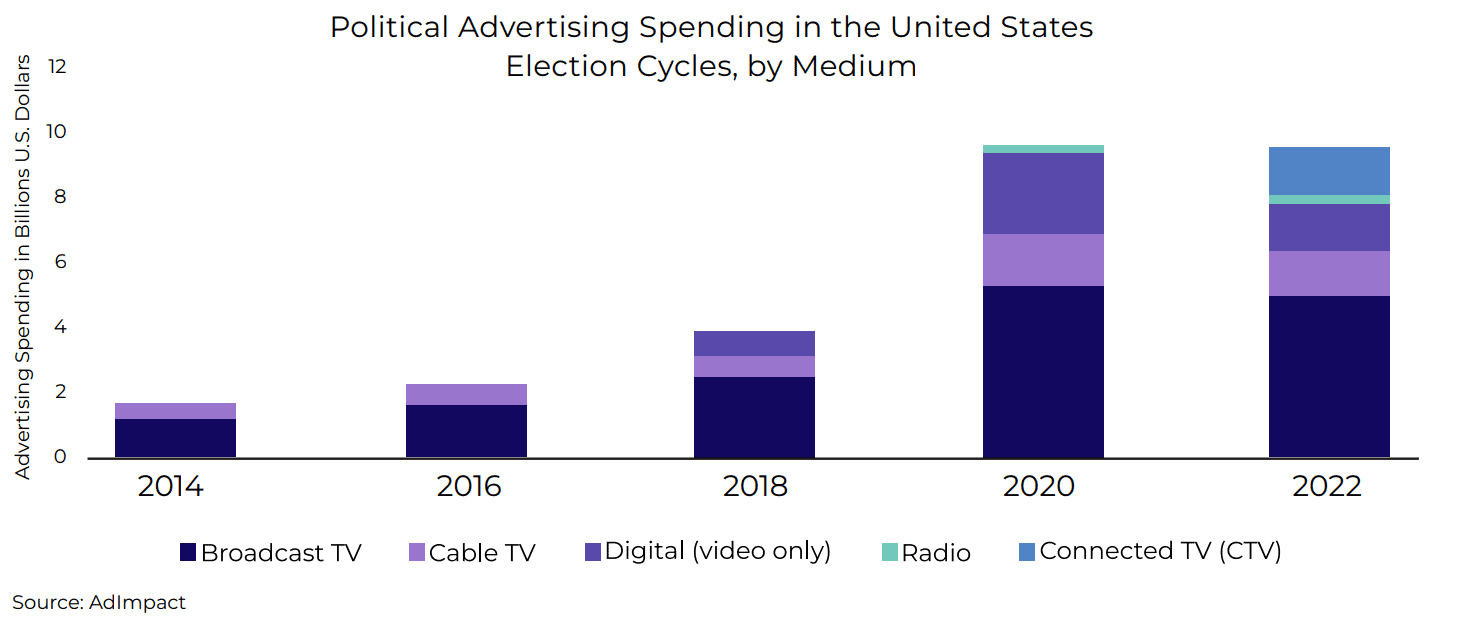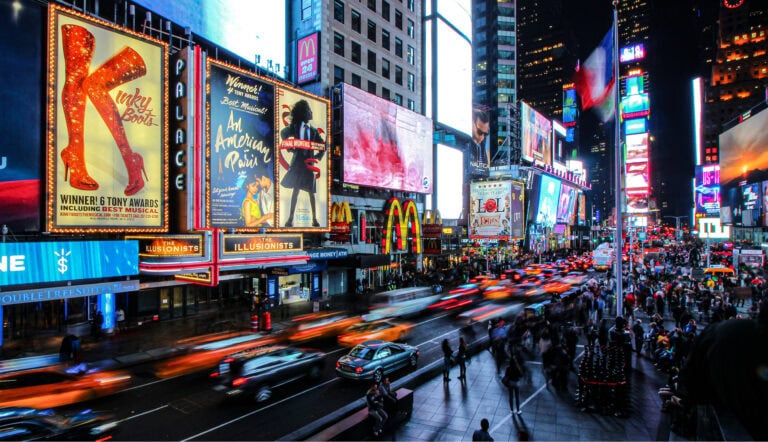Digital Advertising Expenditures Expected to Double
Political ad spending on the 2024 U.S. presidential election has reached record highs, highlighting both campaigns’ need to reach voters at nearly any cost in key swing states. This election cycle, ad spending is expected to reach $12.3 billion, marking a 24% increase over the 2020 cycle (1). Of that, Democratic campaigns and outside groups have spent a total of about $4.5 billion on ads, compared to about $3.5 billion for Republicans (2). The remainder of the projected spending comes from non-partisan groups, third parties, ballot measures, single-issue campaigns and other miscellaneous expenditures.
As political ad spending has increased, the focus of all that advertising has continued to narrow. Historically, spending has been concentrated in select swing states, where ads could potentially influence enough voters to impact the outcome of that state’s election. That trend has continued in 2024, as increasing partisanship has narrowed the universe of persuadable voters.
According to Tim Kay, VP of political strategy at Ampersand, 2024 spending has been intensely focused on less than 3% of registered voters in seven swing states—Pennsylvania, Michigan, Wisconsin, Georgia, North Carolina, Arizona and Nevada. By October 8, presidential campaign ads in these seven states had accounted for $1 billion in advertising on local TV stations, representing 79% of all local TV ad expenditures. (3) Leading up to Election Day, political ad spending in these states is expected to represent 88% of all future local TV ad reservations. (3)
Traditional ad spending through channels like television has historically been the most important way for campaigns to reach voters. This has continued to hold true even in an era where digital advertising, more broadly, has become by far the biggest ad channel in the United States. But in 2024, advertisers saw signs that this was beginning to change.
For instance, when President Biden’s campaign announced its initial advertising reservations in 2020, it allocated 80% of that budget to television. But this year, when the Harris campaign announced it had reserved $370 million in advertising to run from Labor Day through Election Day, it allocated less than half ($170 million) to television ads.
Quentin Fulks, the principal deputy campaign manager for Harris, noted: “This is a modern campaign in 2024, and we’re not just stuck in the times of old, where 80% of the budget has to be on television.” In fact, the largest portion of that $370 million budget was allocated to digital and streaming, or connected tv (“CTV”), advertising (4).

All told, digital advertising’s share of political ad spend in 2024 is expected to double vs. 2020, growing from 14% to 28%. That’s a massive increase – 156% growth in total digital dollars spent, largely driven by CTV growth, which is up 506% vs. 2020 (5).
The Trump campaign, for its part, has focused more of its efforts on traditional media advertisements. Over the past three months, the Trump campaign spent only $6 million on Meta ads, compared to $55 million from the Harris campaign (6). Furthermore, in the final days leading to the election, the Trump campaign spent $35 million on traditional TV advertisements, compared to $30 million for the Harris campaign (7).
However, paid media does not tell the whole story. The Trump team has also benefited from substantial unpaid media coverage, achieving regular virality and receiving 62% of all news media mentions between July 22 and October 7, compared to 38% for the Harris campaign (8).
Even as digital’s share of political advertising has doubled, it still trails the overall ad market’s move towards digital: over three- quarters of all ad dollars spent in the United States go through digital channels, vs. about one-quarter for political ad dollars.
Going forward, we expect to see that trend continue. Political ad spending will likely shift towards digital channels, but that shift will continue to lag the overall ad market’s move to digital, as relevant voters are highly reachable through linear TV ads—traditional, scheduled television programming that viewers watch live. And as attention spans fragment even further, political advertising’s importance in elections will only continue to increase. We expect 2028 to be another record cycle for political advertising.
Digital Advertising Expenditures Expected to Double
Total U.S. Political Advertising Spending
Traditional U.S. Political Advertising Spending
Digital U.S. Political Advertising Spending
U.S. Political Advertising Spending on CTV
Source: EMARKETER
1. US Political Ad Spending Forecast 2024; 2. Democrats outspending Republicans ahead of Election Day 2024; 3. 7 Swing States Have Been Inundated With Political Ads; 4. Harris campaign plans initial $370 million in ads; 5. 2024 Political Ad Spending Will Jump Nearly 30% vs. 2020 – EMARKETER; 6. Harris Vastly Outspending Trump on Social Media in Election Run-Up – Newsweek; 7. $16 Billion Will Be Spent in the 2024 Election. Where’s It All Going? | National News | U.S. News; 8. How the Democrat-leaning news media is unwittingly aiding Trump | Fortune
Read the Article


